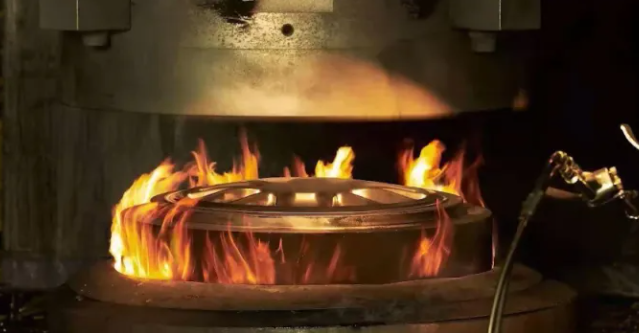Wheel hubs may be classified as either forged or cast. Casting, in its most basic definition, is the process of obtaining castings (parts or blanks) with predefined shapes, sizes, and performances by melting metal into liquid fulfilling particular conditions, and pouring it into the mold to get these characteristics. Here we talk about the best way to tell the difference between a forged wheel hub and a cast wheel hub.

Casting at Low Pressure
To cast aluminum, first secure the mold over a pool of closed, high-temperature aluminum solution; next, using dry compressed air to create pressure in the pool, allow the aluminum solution to enter the mold cavity; and finally, keep the pool pressurized until the casting is complete. In comparison to standard gravity casting, the final material density is higher when a particular amount of pressure is applied during the casting process. Low pressure castings may provide superior performance under same settings. Some very complicated wheel forms may also be cast using low pressure. Unfortunately, gravity casting has its limitations when it comes to casting wheels with more intricate forms because of the limited fluidity of liquid aluminum.
Forging is a manufacturing technique in which a metal blank is subjected to high pressure in order to induce plastic deformation and so create a forging with the desired mechanical characteristics, shape, and dimensions. Aluminum’s density may be improved by forging since it removes imperfections caused by casting, welding, etc. When completed items are forged and cast, it is observed that the cast products are weaker than the forged ones. The price of a forged wheel hub is considerable because forgings have superior mechanical qualities than castings.
The aluminum block of the forged wheel hub undergoes continuous stamping and forming during the manufacturing process, resulting in a molecular structure that is exceedingly tight and capable of withstanding significant pressure. Accordingly, if both the size and strength requirements are met, the forged wheel hub will be lighter than the cast wheel hub.
The cost of forged wheels is high because…
The Making of a Complicated Product
-Feeding and cutting: 6061 aluminum bar, a military-grade aluminum bar, is used for forging the wheel hub, and is then trimmed to the proper size before moving on to the next step in the process.
-Preheat the aluminum bars by heating them in a furnace to the desired temperature, allowing the material to achieve a state of equilibrium before removing it for forging.
-An embryo is fashioned from molten metal using a forging press weighing more than 8,000 tons.
-Spin the raw embryo using spinning wheels that may weigh up to 25 tons each using a vertical spinning machine, which is the fourth powerful spinning formation method.
-Heat treatment, after spinning, the aluminum hub must be treated with heat to reinforce it. As part of the heat treatment procedure, you’ll go through a. high-temperature solution treatment, b. quenching water treatment, and c. low-temperature aging therapy.
-Lathe Work
-Drilling and center-hole processing
-Surface treatment for wheel hubs
Several benefits associated with using forged hubs
-Low-weight and gas-efficient
-It may help the engine last longer.
-Tire and brake pad longevity is increased by its high heat dissipation and low burst resistance.
-Stronger by 30% than a standard casting wheel.
-Quick to get going, with a Short Stopping Distance
-Strong safety performance.
-Better than casting seven times in dynamic balance.
How to Tell If Something Is Forged or Cast by Looking at It
It’s easy to make a good call since the draft angle of a cast wheel hub is often between 7 and 10 degrees, whereas the draft angle of a forged wheel hub is typically between 0 and 3 degrees.
Material must be able to exit from the rear of the casting wheel hub, according to the judgment. A primary goal is to achieve weight loss. The second reason is that it makes symbol engraving easier. The forged wheel hub must have no leaks.
Prudent assessment: the hub of a wheel constructed of high-quality aluminum is denser, resulting in a clearer reverberation of percussion. The sound from the wheel hub is the clearest and the echo may linger for many seconds if the method used is liquid aluminum forging. If there is little to no response when you knock, you should probably give up.
As a general rule, forged rims are thinner than cast rims, but all three types are evaluated based on how they feel in the hand.

